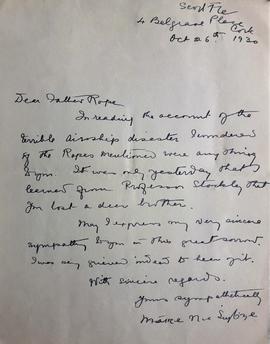A bound volume containing clippings of newspapers and articles (and some correspondence) compiled by Fr. Henry Rope. Some of the content relates to the Irish political situation (1919-22) while there are also articles and ephemera relating to religious subjects with extensive annotations and notes by Father Rope. Typescript annotation on first page reads ‘The Rev. H.E.G. Rope, Plowden, Lydbury North, Shropshire’. The volume was previously a printed publication titled on the spine ‘Empyrean Building’. The contents include:
• Typescript titled ‘The defender of small nations at Millstreet’ with manuscript additions by William Frederick Paul Stockley. (Aug. 1918).
• Typescript titled ‘Statement of Charles Kenny, of No. 1, Ulster Terrace, North Strand, Dublin, taken at the Mansion House, Dublin’. (19 July 1918).
• Letter from Fr. Joseph Darlington SJ, editor of ‘The Irish Monthly’, Rathfarnham Castle, Dublin, to Father Rope referring to ‘Irish Affairs’. (15 Mar. 1922).
• Copies of the ‘Irish Bulletin (London Edition)’. 1922.
• Clippings from the ‘Universe’ and the ‘Catholic Times’ re sectarian riots in Ulster.
• Louis J. McQuilland, ‘The image in the mirror’, ‘The New Witness’ (3 Jan. 1919).
• ‘The death of Right Rev. William Bernard Kelly, Bishop of Geraldton’, ‘The West Australian Record’ (31 Dec. 1921).
• Manuscript copy of a poem titled ‘Inaugural Ode’ by Aodh de Blacam (1935).
• Letters from Fr. Albino, League of International Peace, 22 Ainger Road, London, to Father Rope referring to the Anglo-Irish Treaty and his efforts to promote wider peace and conciliation (1922).
• A clipping of an article titled ‘University Extension / Meeting at Cambridge’, ‘East Anglian Daily Times’ (Aug. 1902).
• ‘Abbey Rebuilt by Monks / Labour of love on the Buckfast Pile / War Memories / Retreat were “enemies” worked in peace’, ‘Daily News’ (3 Mar. 1922).
• Clipping of an article reporting on a sermon on the dangers of proselytism by Fr. Francis M. Browne SJ at St. Francis Xavier Church on Gardiner Street in Dublin (‘Irish Catholic’, 18 Feb. 1922).
• Complete copy of ‘Ár n-Éire / New Ireland’, (14 January 1922). Includes large format advertisement for the Irish White Cross.
• Letter from W.B. O’Dowd, Saint Agnes Academy, Houston, Texas, to Fr. Rope. (10 Mar. 1920).
• Complete copy of ‘Ár n-Éire / New Ireland’, (15 Apr. 1922).
• Complete copy of ‘Ár n-Éire / New Ireland’, (22 Apr. 1922).
• Complete copy of ‘The Catholic Gazette’, Vol. V, No. 3 (Mar. 1922).
• Clipping of an article by Shane Leslie titled ‘Impression of Rome’, ‘Catholic Times’ (1922).
• Articles reporting the death of Pope Benedict XV (d. 22 Jan. 1922).
• Complete copy of ‘The Far East / Organ of Ireland’s Mission to China’, Vol. V, No. 2 (Feb. 1922).
• Clipping of an article titled ‘Extermination Plan in Belfast’, ‘Irish Independent’ (22 Apr. 1922).
• Clipping of a letter article by Maud Gonne MacBride titled ‘The Women of Donegal / How other women may help’ (‘Irish Independent’, 22 Apr. 1922); Clipping of a photograph showing ‘Mrs O’Callaghan and Mary MacSwiney, women members of the Dáil’ (‘Daily Mirror’, 28 Apr. 1922).
• Complete copy of ‘Ár n-Éire / New Ireland’, (29 Apr. 1922).
• Clipping of an article titled ‘The Jews’ by Shane Leslie, ‘Catholic Times’ (29 Apr. 1922).
• Colourized postcard print of Saint Brendan’s Catholic Church in Birr, County Offaly.
• Clipping re Jack B. Yeats’s paintings published in ‘The Leader’ (6 May 1922).
• Complete copy of ‘Ár n-Éire / New Ireland’, (6 May 1922).
• Letter from Andrew Hilliard Atteridge to Fr. Henry Rope (7 May 1922).
• Letter from Lennox Robinson, 1 Clare Street, Dublin, to Fr. Henry Rope. He writes ‘Things are very dark and distracted over here but not more than elsewhere I suppose. Perhaps, somehow, good may come but one often despairs of it’. (3 Apr. 1919).
• Letter from Seumas MacManus, 264 West 94th Street, New York City, to Fr. Henry Rope. (1 May 1922).
• Complete copy of ‘Ár n-Éire / New Ireland’, (13 May 1922).
• Letter from C.E. Chesterton, ‘The New Witness’, 20 & 21 Essex Street, London, to Fr. Henry Rope. Refers to the ‘Irish affairs’ and the Anglo-Irish Treaty. (1 May 1922).
• Letter from Fr. Herbert Vaughan, ‘The Catholic Gazette’, to Fr. Henry Rope. (19 May 1922).
• Copies of the ‘Irish Bulletin (London Edition)’ (May 1922).
• Complete copy of ‘Ár n-Éire / New Ireland’, (20 May 1922).
• Complete copy of ‘The Far East / Organ of Ireland’s Mission to China’, Vol. V, No. 6 (June 1922).
• Letter from Aodh de Blacam, Falcarragh, County Donegal, to Fr. Henry Rope. (1 June 1922).




